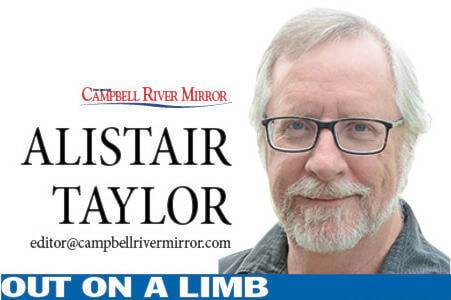Trying a new approach to my column. Instead of sitting down 60 minutes before press deadline and cranking out some thoughts to fill the space on the editorial page (with often dubious – but sometimes brilliant – results), I’ll keep a running tab of my thoughts as they occur to me as the week goes by. Because, you know, it’s really important that you know what I think about everything. That’s sarcasm by the way.
DIVISION OF RESPONSIBILITIES…Saw a social media post about an incident in which a person on the streets of Campbell River saved an overdosing person by running to get a Narcan kit. Awesome action taken by that person. Heroic, without doubt.
But then the subsequent commentary digressed into the usual discourse social media is famous for.
One of the comments was of the oft-repeated rant to the city for not being more proactive in caring for the people with serious problems. There just doesn’t seem to be an understanding of the roles of our levels of government. It’s not the city’s responsibility to care for the health and welfare of the people who live in this – or any other – community. It’s the province’s responsibility. The province hasn’t done what’s necessary.
The city is limited by PROVINCIAL legislation to zoning, garbage collection, sewer, water and a limited set of other practical services. It, sorry, you and I pay for policing with our tax dollars but the RCMP is a federal agency which is contracted by the city to provide policing services. Meanwhile, the Criminal Code of Canada is federal legislation. It’s not a city bylaw.
Sure, the city could get creative and try some things like encourage more buildings being made available for housing. But addiction services, welfare payments and medical treatment – the things that would actually help people dealing with homelessness and addiction – is all funded and managed by the province. The city is not allowed to pay for those things by law. Your city property taxes are dictated by law as to what they can be used for. So unless city councillors are going to get out of their office and go help people on the streets individually, or rezone a building for housing, there isn’t much they can actually do.
If you want action taken, lobby your MLA and the premier. It’s the provincial government and to some extent, the federal government (funds healthcare which the province administers), whose job it is to look after the unfortunate in our community. Well, the province and the residents of the community, for that matter. There’s nothing stopping you from trying to do something to help. In fact, it might be where the actual solution lies.
MAPPING 101...I have been seeing a lot of random posts, articles, thoughts, etc. about the deficiencies of our most commonly-used map. Particularly how it distorts our view of the world.
I’m speaking specifically about the “Mercator projection” type of map. That’s the type of map that hung on the wall or blackboard of practically every classroom in every school in the country for who knows how long. Every day of my school life I was forced to stare at this map of the world hanging on the wall.
Despite that forced viewing, though, I actually love maps.
The Mercator projection, if you don’t know, is a map that handles the problem of representing the surface of a round object on a flat rectangular surface, i.e., the roundish Earth onto a flat piece of paper. It was arrived at as a solution originally in the 1500s. The problem with it is that it distorts the size and shape of the countries, most specifically the extreme north and south. The closer to the middle – the Equator – the more accurate it is.
Consequently, Greenland looks like it is bigger than Africa when it’s not. This distortion came to my attention again recently when someone was pointing out that the distance across Siberia is actually shorter than the distance across northern Africa. That has consequences in our perception, some say. Because the global north – read: wealthy, post-industrial white populations – looks bigger and it looms bigger in our imagination. The concerns and issues the global north faces take on more importance than that of Africa and the global middle and south which are generally depicted as smaller on the map and are perceived as such in our minds. And on our political agendas.
I don’t know if a causal link between the map and our assumptions can be proven but I do agree that the global south has less power and influence than the global north. That’s a fact, as far as I’m concerned.
But my point here is that for some reason this has just been percolating up in various formats lately. I don’t know why, various algorithms are to blame as to why I’m seeing them, I suppose. But it kind of astounds me because the tone of these items is one of discovery. But I’m like “What, you didn’t know that?”
I learned about the deficiencies of the Mercator projection back in Grade 8 or 9 (which was a long time ago for me). Why is this coming to light now? I guess these discussions rise and fall over the years.
